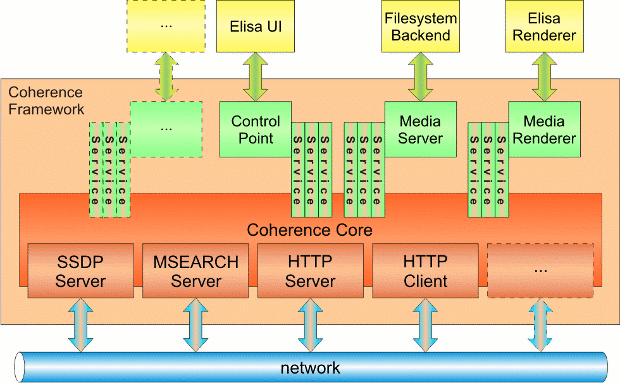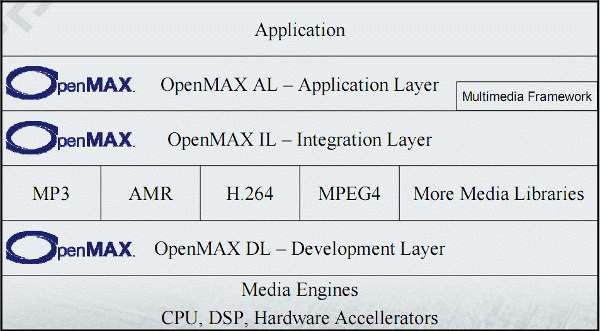Coherence is a DLNA/UPnP Media Server written in Python which exports local files or online media to UPnP clients. Coherence fetch the media files from several sources such as: Local applications media collections, like those from Rythmbox or Banschee, Audio-CD or DVB Online services like Flickr, last.fm, YouTube, Picasa Web Albums and other. Other sources can also be added thanks to Coherence plug-in architecture. The media server supports transcoding (currently experimental) that is to convert media files in another format. Coherence toolkit also contains other packages such as: Coherence-Config: a cross-platform GUI frontend for ‘Coherence’. Cadre: a picture DLNA/UPnP MediaRenderer which can display pictures from the local filesystem or from a MediaServer. Mirabeau: An application level proxy for UPnP devices which allows to share your UPnP content between two or more local networks over the Internet. It uses XMPP as a transport (work in progress). UPnP-Inspector: a graphical UPnP Device […]
Enable OpenGL 2.0 and WebGL for Intel GMA3150 in Ubuntu
I wanted to use WebGL in my Acer Aspire One D255E netbook that uses an Intel GMA 3150 onboard graphics card, but it did not work in Chromium nor Firefox. WebGL requires OpenGL 2.0 support, but I found out I only had support for OpenGL 1.4:
|
1 2 |
glxinfo | grep -i "OpenGL version" OpenGL version string: 1.4 Mesa 7.7.1 |
But I found out it was possible to enable OpenGL 2.0 for GMA 3150 in Linux by installing and running driconf:
|
1 2 |
sudo apt-get install driconf driconf |
and clicking on “Enable limited ARB_fragment_shader support on 915/945.” and “Enable stub ARB_occlusion_query support on 915/945.” options. They are not enabled by default because they do cause problems. After those two options were enabled, OpenGL 2.0 was enabled.
|
1 2 |
glxinfo | grep -i "OpenGL version" OpenGL version string: 2.0 Mesa 7.7.1 |
But I still could not use WebGL in either Chromium nor Firefox, so I decided to install the latest version of Mesa (7.11) with indirect rendering (software) enabled with libOSMesa:
|
1 2 3 4 5 6 7 |
sudo apt-get install libffi-dev wget ftp://ftp.freedesktop.org/pub/mesa/7.11/MesaLib-7.11.tar.bz2 tar xjvf MesaLib-7.11.tar.bz2 cd Mesa-7.11 ./configure --enable-os-mesa --prefix=/usr make make install |
Even with the latest Mesa library, I could not use WebGL […]
Android NDK Revision 7 for Android 4.0 (ICS)
Google has just released Android Native Development Kit Revision 7, the Android SDK that allows developers to reuse C/C++ code. This version adds new native APIs available in Android 4.0. Here’s the changelog of the most important new features and bug fixes: NDK APIs for Android 4.0 (API level 14): Low-level streaming multimedia: A new API based on Khronos OpenMAX AL 1.0.1 provides a direct, efficient path for low-level streaming multimedia. The new path is ideal for applications that need to maintain complete control over media data before passing it to the platform for presentation. Audio decoding into PCM: Extensions to the existing native audio API based on Khronos OpenSL ES let native apps decode compressed audio assets to PCM format. CCache support to allow faster rebuilds. Added support for setting APP_ABI to all to indicate that you want to build your NDK modules for all the ABIs supported by […]
11 Recommendations for Optimizing Mobile Apps Power Efficiency
Following an AT&T Labs Research and corresponding paper entitled “Profiling Resource Usage for Mobile Applications: A Cross-layer Approach“, AT&T found that a few simple design approaches could significantly improve mobile application responsiveness and reduce battery drain by lowering your application power consumption. They analyzed PANDORA internet radio and discovered that the streaming music was delivered efficiently, but periodic audience measurements were draining battery life. Here is an excerpt of the PANDORA Case Study: While the music itself was sent simply and efficiently as a single file, the periodic audience measurements—each constituting only 2KBs or so—were being transmitted at regular 62.5-second intervals. The constant cycle of ramping up to full power (2 seconds to ramp up, 1 second to download 2KB) and back to idle (17 seconds for the two tail times, the first down from full-power mode and the second down from half-power mode) was extremely wasteful. Of the total […]
OpenMAX (Open Media Acceleration)
OpenMAX (Open Media Acceleration) is a royalty-free, cross-platform set of C-language programming interfaces that provides abstractions for routines especially useful for audio, video, and still images. OpenMAX standard is managed by the non-profit technology consortium Khronos Group. OpenMAX allows developers to take advantages of hardware media decoding/encoding. For example, If you want to play video using Raspberry Pi hardware (VideoCore IV GPU in Broadcom BCM2835) you’ll have to use OpenMAX IL. OpenMAX provides three layers of interfaces: Application Layer (AL): Open standard for accelerating the capture, and presentation of audio, video, and images in multimedia applications on embedded and mobile devices. Integration Layer (IL) : API defining a standardized media component interface to enable developers and platform providers to integrate and communicate with multimedia codecs implemented in hardware or software. Development Layer (DL): APIs containing a comprehensive set of audio, video and imaging functions that can be implemented and optimized […]
Linaro’s Android Platform – ELCE 2011
Zach Pfeffer, Linaro Android Platform team leader, describes Linaro’s work on the Android platform and future plans at Embedded Linux Conference Europe 2011. Abstract: Linaro uses components from the Android Open Source Project, member companies, community supported efforts and Linaro engineering teams to build integrated, easy-to-use and well tested Android platforms for upstream work, product baselines and hobby projects. The team currently has platforms for TIs PandaBoard, BeagleBoard and Beagle xM, ST Ericsson’s Snowball, Samsung’s Origen and Freescale’s iMX53. They recently released platforms with Android 2.3.4 built against GCC 4.6 and running the 3.0 Linux kernel. In this session Zach reviews what’s been done, the Linaro Android concept, how Linaro brings Android together and what their plans are. Jean-Luc Aufranc (CNXSoft)Jean-Luc started CNX Software in 2010 as a part-time endeavor, before quitting his job as a software engineering manager, and starting to write daily news, and reviews full time later […]
Archos 80/101 G9 Firmware Version 3.2.69 Released
Archos has just released a new firmware for Archos 80 G9 / 101 G9. Here’s the changelog: Firmware changes Version 3.2.69 – November 9th, 2011 Web browser: faster web page rendering Media center: built in online subtitle download support after a long press on a video file under video browser Media scraper: faster information retrieval process External storage: add ability to mount disks without partition Android version: switch to Honeycomb 3.2.1 Battery: low charge notification Multimedia: support for split AC3, MPEG2 plugins The firmware can be downloaded at http://update.archos.com/9/gen9/gen9_3.2.69/firmware_archos_it4.aos Jean-Luc Aufranc (CNXSoft)Jean-Luc started CNX Software in 2010 as a part-time endeavor, before quitting his job as a software engineering manager, and starting to write daily news, and reviews full time later in 2011. www.cnx-software.com
Using Buildroot For a Real Project – ELCE 2011
Thomas Petazzoni, embedded Linux engineer and trainer at Free Electrons, shows how they used buildroot for a specific project at Embedded Linux Conference Europe 2011. Abstract: Buildroot is a nice, simple and efficient tool to build small to medium sized embedded Linux systems, such as the ones found in many industrial systems or highly dedicated systems. Buildroot allows to automate the process of building a cross-compiling toolchain, building the root filesystem with all userspace components, building a Linux kernel image and a bootloader image. Based on experiences of a specific customer project, Thomas details how Buildroot can be configured and used to quickly produce nice, fast and efficient embedded Linux systems, but also how the target application development and debugging can be done based on Buildroot. You can also download the presentation slides. Jean-Luc Aufranc (CNXSoft)Jean-Luc started CNX Software in 2010 as a part-time endeavor, before quitting his job as […]




